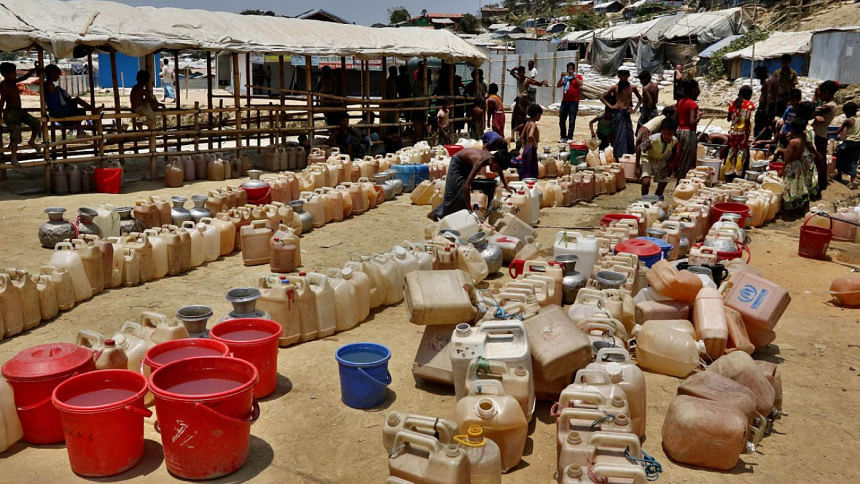Water and sanitation challenges of Rohingyas under spotlight

A global expert on water, sanitation and hygiene presented two cases to address water and sanitation challenges at the Rohingya refugee camps in Bangladesh at the World Water Week in Stockholm.
Antonio Torres, working in operations and emergencies of the International Organization for Migration (IOM) in Geneva, made the presentation at a session on "Refugees and Migrants Promoting Ecosystem Protection and Human Rights".
His deliberations mainly focused on the Rohingya refugees in Bangladesh, the fourth largest refugee concentration in the world. Torres presented two cases of temporary storage of rainwater and biogas-powered community kitchens. Afterwards, he spoke to the Daily Star exclusively.
There have been several waves of Rohingya influx from Myanmar to Bangladesh since 1948 due to tensions with the government. Since then, over one million Rohingya have been displaced in waves that occurred mainly in early '70s, early '90s, between 2012 and 2015 and the largest in 2017 with over 700,000 displaced between August and December.
The large number of refugees coupled with lack of space, undulating terrain, and an intense monsoon, pose a challenging scenario for relief agencies to deliver prompt assistance, especially as far as sanitation infrastructure is concerned.
IOM and other relief agencies are trying to provide water and sanitation services that promote environmental safety and protection and at the same time mitigate negative impacts on the communities.
Torres highlighted two interventions of the IOM in Bangladesh as examples of good balance between human needs and environmental protection.
The first case involves construction of temporary dams for water supply at the Leda refugee camp.
Torres estimates that 26,000 inhabitants of the Leda refugee camp need 360,000 litres of treated water every day, which is a challenge in itself since there is no reliable access to surface or groundwater sources.
Surface water is available during the monsoons while groundwater is not suitable for extraction in large volumes since the aquifer has saltwater, being close to the sea.
The solution, he said, is to construct reservoirs and temporary dams to store water during the rainy season. This way, drinking water is available through the year.
In general, the construction of dams alter the natural flow of the water, affecting ecosystems and the capacity of communities downstream to make use of the water. In order to mitigate the impacts on ecosystems, the dams are temporarily constructed at the end of the rainy season, just before the canals run dry. The dams are taken down at the beginning of the next rainy season to normalise water flow.
Apart from the Rohingya refugees benefiting from access to safe water, the host communities will also benefit since some of the dams have been constructed exclusively for their use -- mainly irrigation -- based on their demands during consultations. Additionally, host communities have been involved in the construction.
The second case related to biogas latrines that used human waste to produce energy for cooking and ensuring safe excreta disposal at the same time.
Recent surveys show that cooking fuel is the highest priority for Rohingya refugees. According to a joint assessment of IOM and FAO in November 2017, the refugee and host communities have substantial environmental impacts ranging from health to safety and security to deforestation and degradation of land.
Torres presented biogas as a firewood alternative.
A biogas plant is generally composed of six latrines and one kitchen. While 120 people benefit with access to latrines, only five households benefit from the single kitchen that six latrines provide gas for. This means that not all the latrine users can benefit from the kitchens.
In order to ensure equitable access to kitchens, a roster system needs to be put in place. This requires a consultation process, in which, apart from agreeing on the roster, the community will also agree to care for and maintain the latrines and kitchens.
There are only about 150 biogas kitchens in the camp, which benefits only a small fraction of the camp population. But however small that is, the kitchens contribute to reducing the impacts of firewood collection on the environment and safely disposing of human excreta.
Until recently, the Bangladesh government restricted construction of permanent infrastructure at the camps, such as biogas latrines, which Torres pointed out was the reason that such plants had not been built at the campsites.
The other reason behind not building biogas latrines, Torres said, was that they are more expensive, take more time to build and need a larger space than a regular latrine. So, in the context of the high number of refugees and urgency of sanitation facilities, biogas latrines are not prioritised.
Moreover, users' feedback shows that they are not very supportive of the biogas kitchens. The users complain having to share kitchens, the smell of biogas and about the irregular supply because the system requires a steady number of users to ensure a continuous flow, which is difficult to control.
Most of these issues could be resolved with better design, monitoring and management, said the expert.
This is a solution that has a lot of potential since it is sustainable, poses little danger to the environment and ecosystems and improves the wellbeing of the communities. “So hopefully we will see more of these latrines in the future at the Rohingya camps,” Torres said.

 For all latest news, follow The Daily Star's Google News channel.
For all latest news, follow The Daily Star's Google News channel. 



Comments